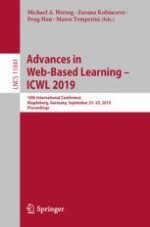2019 | Book
Advances in Web-Based Learning – ICWL 2019
18th International Conference, Magdeburg, Germany, September 23–25, 2019, Proceedings
Editors: Prof. Dr. Michael A. Herzog, Zuzana Kubincová, Peng Han, Marco Temperini
Publisher: Springer International Publishing
Book Series : Lecture Notes in Computer Science
